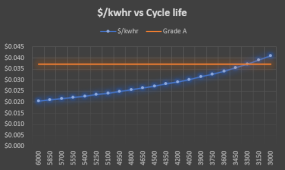For instance, such unknowns:
B cells are the failed to pass certification. Why they failed? There are always some mismanufactured items on production lines. Sometimes you have mismanufactured items, that are still "usable" for some purposes. Like you can see on the video, there is a different reactivity of the cells on current draw and how they recover. In the "storage" use, when you have fairly low cycling (50-150 a year) and low currents, quite much time pass before a mismanufactured B grade cell dies - people rarerly, in this type of use, get to the numbers of cycles and currents the cells are supposed to survive/last - the mismanufactured B grade cells are seen to be fit for purpose of energy storage (especially DIY). Different situation is with electric vehicles - where cycling can be frequent (people driving cars as part of work) and where also stress on the batteries is much higher - high currents going in and out of the cells in the frequent cycles.
The big problem with mismanufactured cells is that there is no one reason why the cells fail pass tests. They simply are not meeting expectation of a final product and are considered waste. The waste is bought by resellers like Docan (who are liers), selected and sold to us as a "A grade" cells. Only after such malpractice manufacturers see damage these resellers make to them and start marking cells - like EVE did with the "B" mark. Hope this marking by manufacturer will be a standard, so it will be harder for Docan and others scam us.
Like this video, because it shows how different the 4, "B grade" cells can be - one of them nicely keeps voltage despite high current draw while the other barely hanging on... You simply do not now what you get and one cell can cause lots of pain in your system. If you are a sole DIY and can manage failure of system - which most of DIYers can in their personal use then you'll likely live. If you are building system for someone or take on yourself risk of guarantee or need a solution you want make and forget about, then use of B cells is a risk to your activity.






